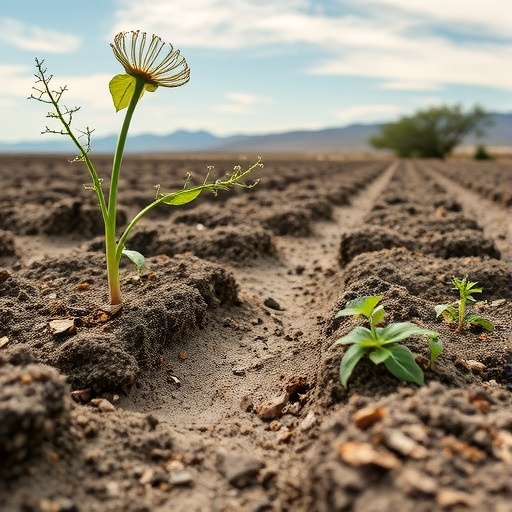In the arid landscapes of our planet, microbial life demonstrates an exceptional ability to resist environmental extremes. A recent groundbreaking study conducted by Ayala-Ortiz, Freire-Zapata, and Tfaily sheds light on the underlying mechanisms that enable microorganisms to flourish in some of the harshest conditions on Earth. Their research, published in the journal Commun Earth Environ, reveals how stochastic assembly processes and metabolic network reorganization contribute significantly to microbial resilience in arid soils.
In ecosystems characterized by extreme aridity, the survival of microbial communities hinges on their ability to adapt and reorganize in response to fluctuating environmental pressures. This study illustrates that stochastic assembly—where random processes influence community structure—plays a crucial role in shaping the resilience of microbial populations. Unlike ecosystems governed by deterministic factors, where species composition might stabilize around certain equilibria, arid soils are characterized by unpredictability, compelling microbes to innovate and adapt constantly.
The research highlights how stochastic events, such as environmental disturbances and nutrient availability, can lead to unexpected community dynamics. As microorganisms establish connections and interactions within their metabolic networks, they create a web of relationships that support their survival. The researchers observed that shifts in environmental conditions prompted these microbial communities to reorganize their metabolic pathways, allowing them to capitalize on available resources efficiently. This dynamic metabolic flexibility is vital for thriving under conditions where water and nutrients are scarce.
One of the remarkable findings of this study is the identification of specific metabolic pathways that become active during times of stress. The ability of microbes to switch metabolic gears and engage alternative pathways means they can utilize varied substrates. This metabolic reorganization enables them to produce energy and necessary biomolecules even when their conventional pathways might be compromised due to environmental constraints. For instance, when faced with drought, several microbes were found to enhance their capacity for utilizing osmoregulatory compounds that are crucial for maintaining cellular function in hyper-concentrated soils.
The researchers also characterized the notion of resilience in these microbial ecosystems. Resilience, in this context, is defined not just as the ability to survive adverse conditions but also to return to a functional, healthy state after experiencing disturbances. The study revealed that microbial communities exhibit a range of resilience strategies, including enhanced genetic diversity and functional redundancy. In such communities, various species can fulfill similar roles within the metabolic network, ensuring that if one species is compromised, others can take over its functions, thus ensuring survival.
Moreover, the research emphasizes the importance of understanding microbial interactions within their communities. Mutualistic and antagonistic relationships can significantly influence the overall resilience of these ecosystems. For example, certain bacteria may produce metabolites that benefit the growth of neighboring species while simultaneously competing for the same resources. Recognizing these intricate interactions is critical for grasping the full picture of microbial resilience and adaptability in the face of climate challenges.
As climate change continues to alter environments globally, the findings from this study have profound implications. Understanding how microbial communities adapt to extreme conditions could inform efforts to harness these organisms for bioremediation and soil restoration initiatives. By learning from nature’s own strategies, researchers and environmentalists can develop sustainable solutions for combating soil degradation and supporting ecosystem services in arid regions, which are increasingly at risk due to climate fluctuations.
The authors of the study advocate for future research focusing on the long-term stability and functionality of microbial communities in arid soils. By employing advanced techniques such as metagenomics and metatranscriptomics, scientists can gain deeper insights into the genetic and functional potential of these resilient organisms. Unpacking the complexities of microbial interactions and community restructuring will be vital for predicting how these ecosystems respond to ongoing environmental changes.
The findings also raise critical questions about the impact of human activities on natural microbial resilience. Practices such as over-farming, deforestation, and the use of chemical fertilizers can disrupt these delicate ecosystems. If the stochastic processes that foster resilience are hindered by anthropogenic factors, the ability of microbial communities to adapt may diminish, leading to decreased soil health and productivity.
In conclusion, the research conducted by Ayala-Ortiz and colleagues marks a significant step forward in our understanding of microbial resilience in arid soils. It elucidates the complex interplay between stochastic assembly and metabolic reorganization, providing a detailed framework for understanding how these organisms navigate their challenging environments. As the planet grapples with escalating climate crises, prioritizing research in microbial ecology can pave the way for innovative conservation practices that leverage the inherent strengths of microbial communities.
This study underscores the necessity of a multidisciplinary approach to ecological research. By intertwining microbiology, ecology, and climatology, scientists can formulate more comprehensive models that predict ecosystem dynamics under stress. Building a robust understanding of microbial resilience will not only advance scientific knowledge but also equip us with the tools needed to foster sustainability in our changing world.
Indeed, Ayala-Ortiz, Freire-Zapata, and Tfaily have contributed invaluable insights into the resilience of microbial life in arid environments. Their research not only enhances our understanding of microbial ecology but also reinforces the profound relevance of these tiny organisms in broader environmental contexts. The resilience mechanisms discovered in this study provide hope that even in the face of extreme conditions, life finds a way to endure and adapt. As we move forward, leveraging these discoveries could be key to addressing the pressing environmental challenges that lie ahead.
Subject of Research: Microbial resilience in arid soils
Article Title: Stochastic assembly and metabolic network reorganization drive microbial resilience in arid soils
Article References:
Ayala-Ortiz, C., Freire-Zapata, V. & Tfaily, M.M. Stochastic assembly and metabolic network reorganization drive microbial resilience in arid soils.
Commun Earth Environ 6, 647 (2025). https://doi.org/10.1038/s43247-025-02637-y
Image Credits: AI Generated
DOI: 10.1038/s43247-025-02637-y
Keywords: microbial resilience, stochastic assembly, metabolic network reorganization, arid soils, climate change, ecological research, microbiology, ecosystem dynamics.




